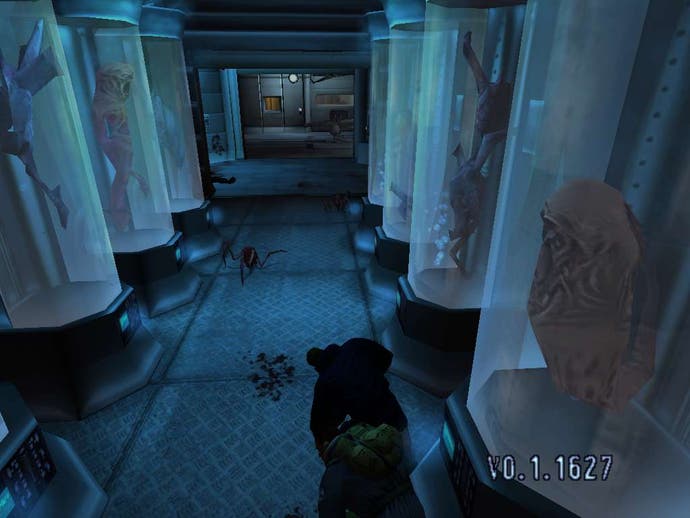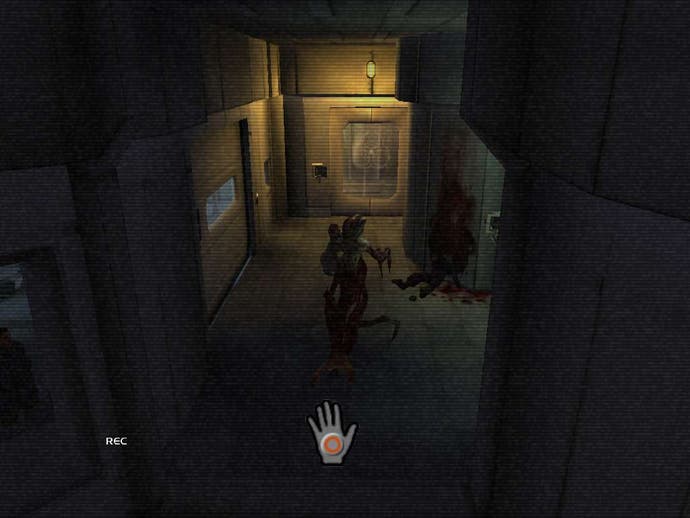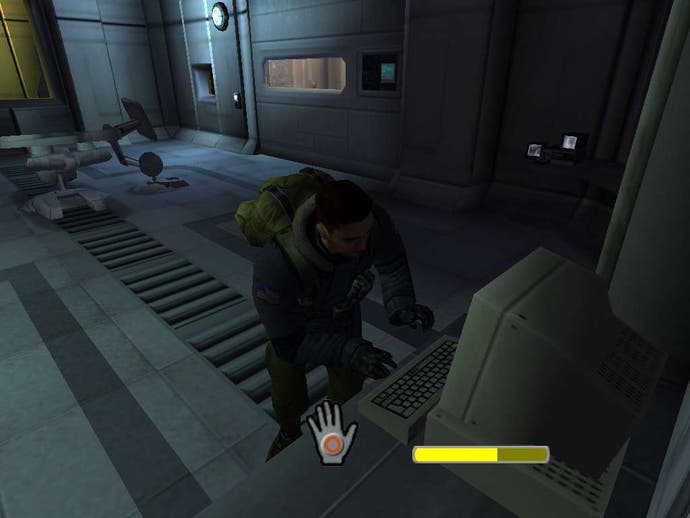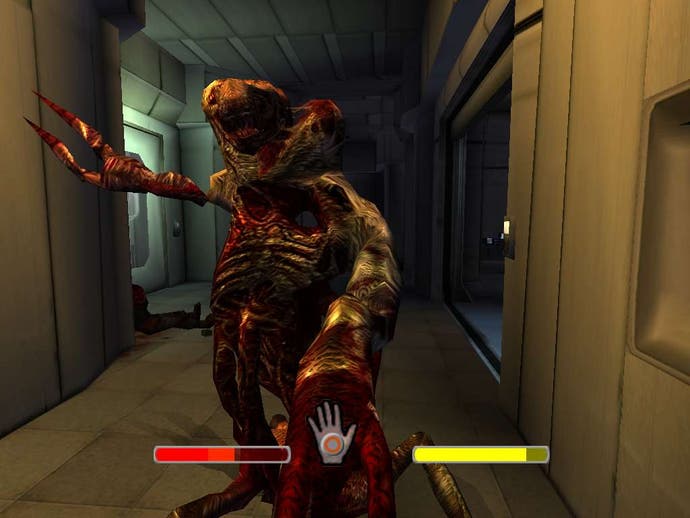The Thing review
Hands On - one of John Carpenter's greatest movies comes to the PC and next-gen consoles, and boy is it good
When we left them way back in 1982, Kurt Russell (MacReady) and Keith David (Childs) had just stumbled out of the flaming wreckage of their Antarctic base after an encounter with The Thing, a terrifying alien lifeform able to imitate any living creature it touched. "Why don't we just wait here for a while, see what happens", MacReady suggests in the closing shot. Well, twenty years later we're about to find out whether this was really a good plan...

Wait And See
Computer Artworks' new videogame adaptation acts as a sequel to The Thing, picking up the story from where the movie left off. A squad of marines have been flown into the North 31 station to explore the ruins of the base and, in true horror fashion, at first everything is eerily quiet, giving you only glimpses of the terror to come. A frozen corpse is still sitting in the burnt out hut from that famous final scene (we won't spoil it for you by telling which of the two survivors it is) and a mangled body lies in the remains of the infirmary.
Initially the game takes you into familiar territory, exploring first the American base and then the Norwegian camp. MacReady's final tape recording is still lying in the ruins of his shack, and bits of Blair's notes on the Thing's biology can be found scattered around the base as well, giving those not familiar with the film a bit of background on what they are facing. Parts of the movie sets have been recreated faithfully, and you'll be able to examine Blair's underground science project and break into the room where the Thing was first defrosted by the Norwegians.
It's at about this point that all hell breaks loose and the game takes off in a completely different direction, carrying you out across the Antarctic to new settings such as secret laboratories and scientific outposts. It's not just the settings which change either - the gameplay varies from level to level, with some missions being straight run and gun affairs as you take on hordes of Thing beasts while others are more puzzle-oriented.

Helping Hand
These puzzles aren't particularly taxing, but they are ingenious in places. As well as the usual collecting of key cards and passwords, you'll also have to repair junction boxes to restore electricity to portions of a base, use sprinkler systems or fire extinguishers to get past walls of flame, and take control of CCTV cameras to read the code number for a door from the whiteboard on the other side of it.
You can't do everything for yourself, either. Up to three characters accompany you at any one time, and these often include a medic and an engineer. Using the simple on-screen squad menu, you can give basic orders to your men such as "follow me" and "stay here", tell medics to heal a specific character, order an engineer to tinker with a piece of equipment that's too complex for you to fix yourself, and exchange weapons and ammunition amongst your men.
In all there are about thirty human characters scattered throughout the game, some of which must be kept alive if you are to complete a level, while others are expendable. And, unusually for an action game, all of them have their own unique voices and faces. These aren't just generic Barneys, they're important to the success of your mission and react to the shocking events around them in a shockingly life-like manner.

Fear Itself
The game's NPCs are governed by two primary motives - fear and trust. If somebody sees too many Thing beasts, mangled corpses and blood-soaked rooms they'll start to freak out. Scared men will cower in the corner, throw up, piss themselves, run away or (in extreme cases) even commit suicide to avoid being taken over by the Thing parasite.
Trust is equally important, as men who no longer trust you will question your orders. Again, this is something that players aren't used to seeing in an action game. If you avoid fighting, take your men's weapons away from them, leave them and wander off alone for a long time, or walk around aiming your gun at them, they'll start to trust you less. You also have to worry about whether or not you should trust them, as your men can become infected in combat without showing it. Only when they have you alone or outnumbered will they emerge from hiding, and it can be a terrifying experience to find some of your squadmates suddenly bursting out as tentacled Thing creatures in the middle of a battle. Occasionally you can run blood tests on other characters to check whether they're still human, but otherwise it's up to you to decide if they're infected.
Although the mechanics behind the trust and fear systems are relatively simplistic, the behaviour that results from them can be almost human at times. In one case, I saw a player lob a grenade to clear a pile of crates, but the blast from the explosion accidentally caught one of his men and knocked him over. The wounded soldier walked up to his leader and politely asked him for a gun, and when the player rather stupidly gave him one, the marine promptly turned round and shot him in the face with it.

Scary Monsters
It's not just your own men that you have to worry about - most levels are crawling with Thing beasts, which come in a range of gruesome shapes and sizes. There are tiny headcrab-style scuttlers, inspired by the scene in the movie where a character's head detaches itself and runs off on spider-like legs. Moving up the scale, full size Thing beasts spawned out of infected humans may have extra heads, holes in their body, acid spittle, giant claws, tentacles or birth sacs which produce scuttlers. Finally there are huge multi-stage "eruptions", like the one seen in the dog pen in the movie, which act as bosses.
By way of defence you have access to a range of weapons, from pistols and shotguns up to machineguns and, of course, flamethrowers. The sight of the flamethrower in action is guaranteed to bring a smile to your face, and the real-time lighting effects used by the crimson flares (again lifted from the movie) are also beautiful to behold. As well as lighting your way, flares can be thrown to ignite flammable liquids, either in barrels or as slicks leaking across the floor.
Although the creaky old E3 preview code for the PC was virtually unplayable, we're happy to report that things have come a long way since then. The controls in the more recent console builds which were on display at a press event in London that we attended last month are easy to get to grips with on PS2 and Xbox alike. The left analogue stick moves and turns your character while the right one strafes left and right. Other buttons within easy reach are used for firing your gun, using equipment such as flares in your other hand, and accessing the inventory and squad menus. There's a bit of auto-aiming to help you target your guns with the gamepad, and the whole thing is a joy to use.
Conclusion
The Thing is rapidly becoming one of our most anticipated games of the year. The graphics are beautiful on all three platforms, the gameplay innovative and the John Carpenter pedigree unimpeachable. If the rest of the game can live up to the high standards of the levels that we've played our way through so far, we should be in for a treat come September 20th.

